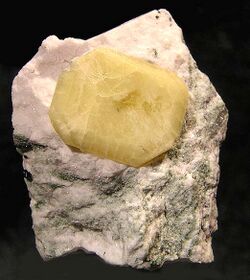Chemistry:Narsarsukite
From HandWiki
| Narsarsukite | |
|---|---|
 1.3 cm crystal of narsarsukite from Mont Saint-Hilaire | |
| General | |
| Category | Silicate mineral |
| Formula (repeating unit) | Na 4(Ti,Fe) 4[Si 8O 20](O,OH,F) 4[1] |
| Strunz classification | 9.DJ.05 |
| Crystal system | Tetragonal |
| Crystal class | Dipyramidal (4/m) H-M symbol: (4/m) |
| Space group | I4/m |
| Unit cell | a = 10.72, c = 7.95 [Å]; Z = 4 |
| Identification | |
| Color | Honey to lemon-yellow, reddish brown, brownish gray, tan, pink; may be green from inclusions; may show color zoning |
| Crystal habit | Occurs as flat tabular to equant, striated crystals In divergent, radiating groups; massive |
| Cleavage | Good on {100} and {110} |
| Fracture | Uneven to subconchoidal |
| Tenacity | Brittle |
| Mohs scale hardness | 5.5 - 7 |
| |re|er}} | Vitreous, pearly on {110} |
| Streak | White |
| Diaphaneity | Transparent to translucent |
| Specific gravity | 2.64-2.83 |
| Optical properties | Uniaxial (+) |
| Refractive index | nω = 1.609 nε = 1.630 |
| Birefringence | δ = 0.021 |
| Pleochroism | Weak; O = colorless to yellow; E = colorless to honey-yellow |
| References | [2][1][3] |
Narsarsukite is a rare silicate mineral with either the chemical formula Na
2(Ti,Fe3+)Si
4(O,F)
11[2] or Na
4(Ti,Fe)
4[Si
8O
20](O,OH,F)
4.[1]
It was first described in 1900 for an occurrence in the Narsarsuk pegmatite in the Ilimaussaq intrusive complex of West Greenland.[1] It has also been reported from a syenite which intruded limestone in the Sweetgrass Hills, Montana, and within hornfels and marble xenoliths in the alkalic intrusive of Mont Saint-Hilaire, Quebec.[2] It occurs associated with aegirine, microcline, albite, elpidite, epididymite, taeniolite, pectolite, calcite, galena and quartz.[2]
References
- ↑ 1.0 1.1 1.2 1.3 Narsarsukite on Mindat.org
- ↑ 2.0 2.1 2.2 2.3 Handbook of Mineralogy
- ↑ Narsarsukite data on Webmineral
- ↑ Warr, L.N. (2021). "IMA–CNMNC approved mineral symbols". Mineralogical Magazine 85 (3): 291–320. doi:10.1180/mgm.2021.43. Bibcode: 2021MinM...85..291W.
 |


